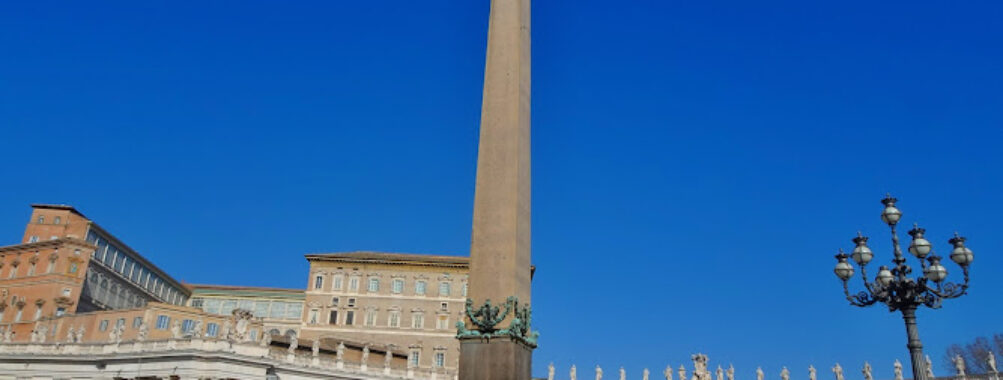
St. Peter Square Obelisk
“`html
Table of Contents
Description
The obelisk standing tall in the center of St. Peter’s Square is one of those landmarks that immediately makes you pause. It’s not just a piece of stone—it’s an ancient Egyptian monument that’s been through more lives than most of us can imagine. Originally brought to Rome by Emperor Caligula in the first century, it once stood in the Circus of Nero, where early Christians, including St. Peter himself, were believed to have been martyred. Later, in the 16th century, Pope Sixtus V had it moved to its current spot in front of St. Peter’s Basilica. Imagine the logistics of shifting a 25.3-meter granite block weighing over 300 tons without cranes or modern machinery—it’s mind-blowing.
The obelisk itself is stripped of hieroglyphs (unlike many of its cousins in Rome), but it’s crowned with Christian symbols: papal coats of arms, a bronze cross, and relics said to be from the True Cross. To me, that juxtaposition is fascinating. Here’s a pagan monument, once dedicated to the sun god, now rebranded as a Christian symbol pointing heavenward. Some people see it as a contradiction, others as a powerful example of transformation. Either way, it’s one of those rare places where history feels layered—you can almost sense the tug-of-war between empires, faiths, and centuries.
Most visitors are awestruck by its sheer size and presence. Sure, a few might shrug and say, “It’s just a big rock,” but standing under it, surrounded by Bernini’s colonnade and the grandeur of the basilica, you realize it’s more than that. It’s a witness to 2,000 years of human ambition, spirituality, and survival. And honestly, even if you’re not into history, it’s hard not to be impressed by the fact that this thing has been standing upright for millennia while entire civilizations rose and fell around it.
Key Features
- Height: 25.3 meters (41 meters including the base and cross)
- Material: Solid red granite, quarried in Egypt
- Age: Over 3,000 years old, originally from Heliopolis, Egypt
- Transported to Rome by Emperor Caligula around 37 AD
- Relocated to St. Peter’s Square in 1586 under Pope Sixtus V
- Topped with a bronze cross said to contain relics of the True Cross
- Serves as the central axis of Bernini’s grand colonnade in St. Peter’s Square
- One of the 13 surviving ancient obelisks in Rome, and the only one not inscribed with hieroglyphs
- Surrounded by a compass rose and marble markers indicating wind directions
Best Time to Visit
If you’re planning to see the obelisk, timing makes all the difference. Early mornings are magical—the square is quieter, the light is soft, and you can actually hear your own footsteps echoing on the cobblestones. By midday, the area fills up with tour groups, selfie sticks, and the occasional pigeon making a dramatic flyby. Sunset is another favorite of mine; the obelisk casts a long shadow across the square, and the warm glow of the sun against the basilica is unforgettable. Winters tend to be less crowded, while spring and fall strike a nice balance between good weather and manageable crowds. Summer, though? Be ready for heat, queues, and lots of company.
How to Get There
Reaching St. Peter’s Square is straightforward, whether you’re staying in Rome or just passing through. The closest metro stop is Ottaviano on Line A, about a 10-minute walk from the square. Buses also stop nearby, though traffic in Rome can be unpredictable, so give yourself extra time. If you’re up for it, walking from central Rome is actually a lovely option—you’ll wind through charming streets and suddenly emerge into the vast openness of the square, with the obelisk right in the middle. Taxis and ride-shares are available, though they can’t drop you directly in the square itself. And yes, there are paid parking lots nearby, but honestly, driving in Rome is not for the faint of heart.
Tips for Visiting
Here are a few things I’ve learned from my own visits (and from watching countless tourists figure it out the hard way):
- Arrive early: You’ll dodge the crowds and have a chance to really take in the obelisk without distractions.
- Look down as well as up: The marble compass rose around the base often gets overlooked, but it’s a neat detail that adds context to the monument.
- Bring water and sun protection: The square is wide open, with very little shade. On hot days, it feels like standing in a giant stone oven.
- Accessibility: The square is wheelchair-friendly, with accessible entrances and parking, which makes it easier for everyone to enjoy.
- Combine your visit: The obelisk is just one piece of the St. Peter’s experience. Pair it with a climb to the dome, a peek inside the basilica, or even a Scavi Tour if you can snag a ticket.
- Take your time: Don’t just snap a photo and move on. Sit on the steps, watch people from all over the world gather here, and let the centuries sink in.
- Photography tip: The best angles often come from the edges of the square, where you can capture the obelisk framed by Bernini’s colonnade.
Visiting the St. Peter’s Square Obelisk isn’t just about ticking off a landmark. It’s about standing in the middle of history, feeling the weight of centuries pressing down, and realizing that you’re part of a much bigger story. Whether you’re fascinated by Egyptian relics, papal history, or just love seeing something truly massive up close, this obelisk delivers. And honestly, even if you come with no expectations at all, you’ll probably leave with a sense of awe. I know I did, every single time I’ve been there.
“`
Location
Places to Stay Near St. Peter Square Obelisk
Find and Book a Tour
Explore More Travel Guides
No reviews found! Be the first to review!